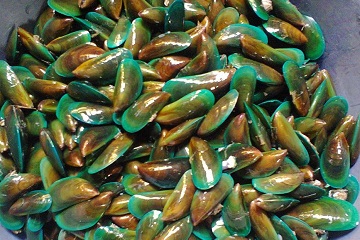A Group of IPB Researchers Utilized Green Mussels as an Alternative Raw Material for Fish Feed

Today, according to the most recent estimate by the UN, there are 7.3 billion people living in the word, and they may reach 9.7 billion by 2050. This growth, along with rising incomes in developing countries (which cause dietary changes such as eating more protein and meat) are driving up global food demand. Increased food demand has driven demand for cultivated food products, such as fish. It is a widespread, affordable and healthy source of valuable protein, so too do the required natural resources needed to produce aquaculture feed. There is no question, therefore, that the global demand for fish will intensify in future. While all animals needs to eat and all farmed animals need to be fed, thus the impact increased production of cultivated fish also demand the increase of fish feed. Eighty (80) percent of fish feed raw material are still imported. Local feed raw materials are only 27 percent, while local fish oil is only 10 percent. Locally available raw materials such as bran, cassava, have disadvantages such as is low in protein, high coarse fiber, and anti-nutritional properties.
Another locally available, alternative feedstuffs can be used to be utilized is the Asian green mussel or Perna viridis. A group of researchers of the Department of Aquaculture, of the Faculty of Fisheries and Marine Sciences, of Bogor Agricultural University (FPIK IPB), Dedi Jusadi explained that green mussels or Perna viridis is currently being recognized as a cheap protein sources, containing high nutritional values and it is popular for its delicious taste. Omega-3 fatty acids are essential fats that have numerous benefits for health. However, not all omega-3 fatty acids are equal. The three most important ones are ALA, EPA and DHA. EPA and DHA are two long chains of Omega-3's polyunsaturated fatty acids.
"The green mussels could be an alternative to fish meal. Mussel is very potential to serve as an alternative raw material for fish feed, regarding protein level and quality. Mussel is a biota with rapid growth and reproduction rate, its productivity reaches 116 tons per hectare per year. In 2014 it reaches 51,870 tons per year in Jakarta Bay, mussel cultivation has positive environmental effects and could make it possible to remove nitrogen from waters. Mussels may be temporarily contaminated with toxins caused by bloom events of toxic algae. This is the largest threat to the development of financially viable mussel farming in Indonesia, "he said.
On the other hand, polluted water in Jakarta Bay, especially from heavy metal, affects the organism that live in this area. Green mussels have the ability to accumulate high metal concentrations without metabolizing the metals. Consequently, it will cause death, carcinogenic effects, teratogenic and mutagenic appreciably. the heavy metals content, namely Mercury (Hg) 0.471 ppm, Cadmium (Cd) 0.80 ppm, and Lead (Pb) 16.94 ppm in water, sediments and mussels organs and the part of mussel malformations. Adding humic acid (HA) fukvat acid provided a breakthrough in removing these metals. When used as feed raw material of fish, the deficiency can be overcome by the addition of humic acid or, which will remove the heavy metals so that the hazardous substances are not loner available in fish meat.
" A major component of naturally occurring DOC is humic acid (HA), as it can represent up to 90% of DOC. Humic acid has excellent binding properties and electrostatic interactions with heavy metals, leading to metal-organic complexes. We have tested the tilapia, so the green shell is mixed with other raw materials used as fish feed, then we add humic acid, which can bind heavy metals, and it turns out by using this fish grow faster. The feed efficiency is good and the meat does not contain heavy metals, "he explained.
Proteins are organic compounds composed of amino acids that comprise about 70% of the dry weight of fish muscle. Since protein is in a dynamic state, continually being synthesized and degraded, a dietary supply is needed throughout life to provide amino acids and nonspecific nitrogen for maintenance and growth. In the future, the researcher hopes that the green mussels seedlings will be distributed to other northern coastal areas (pantura) or other coastal communities. Especially areas which are contaminated with high concentrations of heavy metals, green mussels should be stocked to increase the productions of green mussels for alternative feed raw material of fish, they increase the welfare of coastal communities will increase and the reduce negative impact of organic waste in coastal waters.
"Hopefully there will be a company that will buy or accommodate the mussels. Mussel meal produced from undersized mussels, grown specifically to reduce the overload of nutrients in certain areas or grown in co-culture in areas of finfish farming can be efficiently used to replace fishmeal in fish feed. While the mussel shell is a hard ceramic material which can be used in ceramic industry, of course they need the support of the government, "he said. (Wied)



